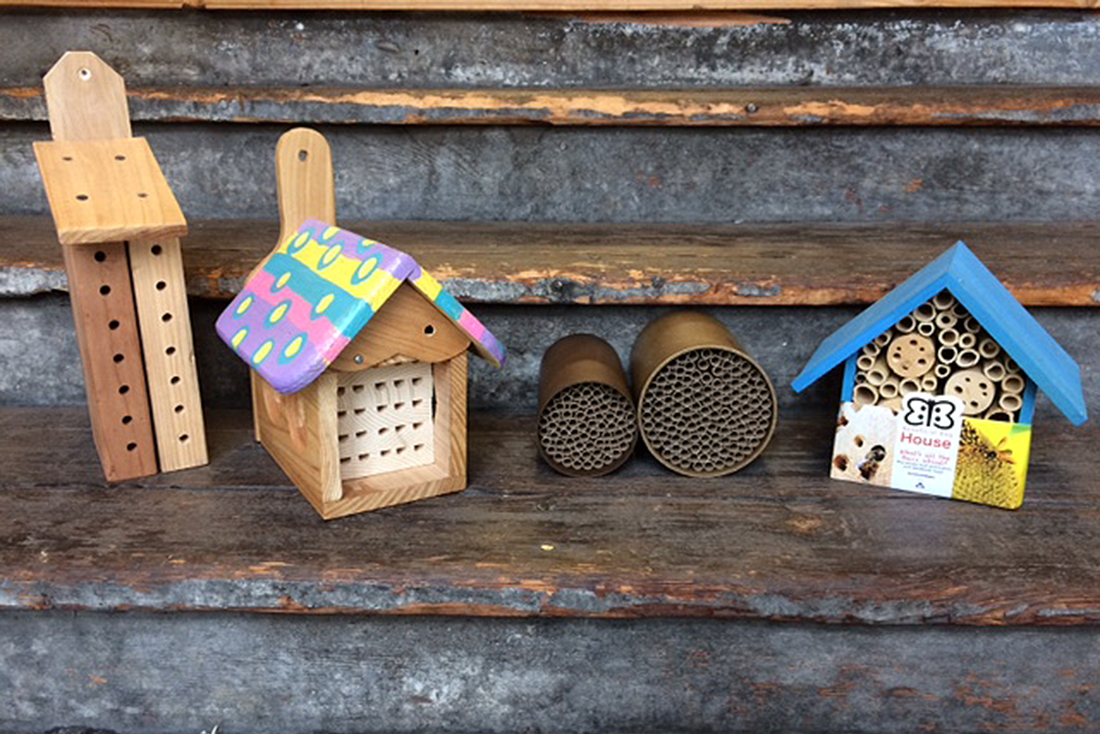What is a Mason Bee?
The name “Mason Bee” comes from the female’s mortar-like application of mud to seal off her egg chambers. Mason Bees are gentle, solitary, and non-aggressive bees, making them an excellent garden companion. They are tremendous early-season pollinators during the fruit tree bloom time. They can improve fruit set of nearly every plant within 100 yards of their home!
The Mason Bee Life Cycle
The female mason bee lives a solitary life, foraging nectar and pollen for her 30-35 eggs. Her adult lifespan is about 4-6 weeks. The male mason bee emerges from his cocoon for one exciting moment of spring mating, then perishes.
Mason Bees vs. Honey Bees
• Mason bees have more hair, and accumulate dry pollen all over the underside of their abdomen to scrape off later in the hive, instead of wetting and sticking the pollen to their legs like the honeybee.
• They are solitary bees with no queen.
• Female mason bees have stingers but rarely use them.
• They work in cool, rainy weather while honey bees remain in the hive.
• They have black bodies, enabling them to warm up in the sun faster.
• They are less susceptible to disease than colony forming bees.
• They have a shorter lifespan and die late spring.
• They produce no honey or beeswax.
A Few Available Housing Options
We carry the following structures for mason bees:
Block Houses
Observation Houses
Nesting Blocks
Where To Place Your Houses
Place your mason bee houses in a south or east-facing location with access to plenty of morning sunlight. You don’t want your bees to bake in the afternoon heat. Be sure to place the houses about 8 feet off of the ground, and tuck them under an eave for rain protection.
Be sure to place houses near the food source (the plants/trees you want your bees to pollinate) as the flying range of a mason bee is short; anywhere from 100-300 feet. If you have a lot of fruit trees, consider placing several nesting boxes throughout your yard.
The female will need mud to secure her young in the nesting box, so providing a mud source nearby will deter her from seeking a different location to lay their eggs.
When to Put Cocoons Outdoors
We carry mason bee cocoons here at our store starting in mid-February. They are sourced locally, and each pouch contains 30 cocoons: 12 males and 18 females.
Place cocoons outdoors when the fruit trees in your neighborhood begin to bloom. Place the cocoon box in the attic of your mason bee house, or tape it underneath of the house, ensuring that a small hole of about 5/16” or 3/8” is open for the newly hatched bees to crawl out of.
Storing Your Cocoon-Filled House
In Mid-June when you no longer see bees coming and going, carefully store your mason bee house in a shed or garage, ensuring that it doesn’t overheat.
Potential Mite Problem For Mason Bees
The hairy-footed mite (Chaetodactylus krombeini) also known as a pollen mite, is a common parasite found on mason bee cocoons, and can be detrimental to both young and adult mason bees.
While out gathering pollen, bees unknowingly pick up one of the hitchhiking female mites and bring them back to the nest, where the mite will lay eggs in the brood cells near mason bee larvae. The mites will feed on the bee larvae pollen stores, bee eggs, and larvae.
When mites infest a nest and adult bees emerge from the infected nest the following spring, the mites can climb onto bees and hitch a ride to a new location.
In the wild, mason bees rarely reuse the same nesting cavity. Having a thorough yearly “house cleaning” is quite important as a steward of these hard-working, wonderful pollinators. That’s all it takes to foster a healthy mite-free population for your overwintering mason bees, and promotes success for the next generation.
DIY House and Cocoon Cleaning
If you wish to do it yourself and harvest your own cocoons, wait until the fall season arrives then very carefully tear open the paper tubes to remove the cocoons. Put the cocoons on a sieve, run cool water over them, and very gently move them around with a paint brush to dislodge any mites.
Store the cleaned cocoons in a mouse-proof box in your shed or garage. (make sure whatever mouse proof container you store them in has some small air holes for ventilation. After you’ve both removed and cleaned the cocoons, clean the house by submerging it in a water bath for 10 minutes, then scrub off any accumulated debris and let dry thoroughly.
If you have a drilled block mason bee house, soak it in a water bath; then use a garden hose to blast out the holes. Sterilize the house in the oven at 150˚ F for 1/2 hour.

